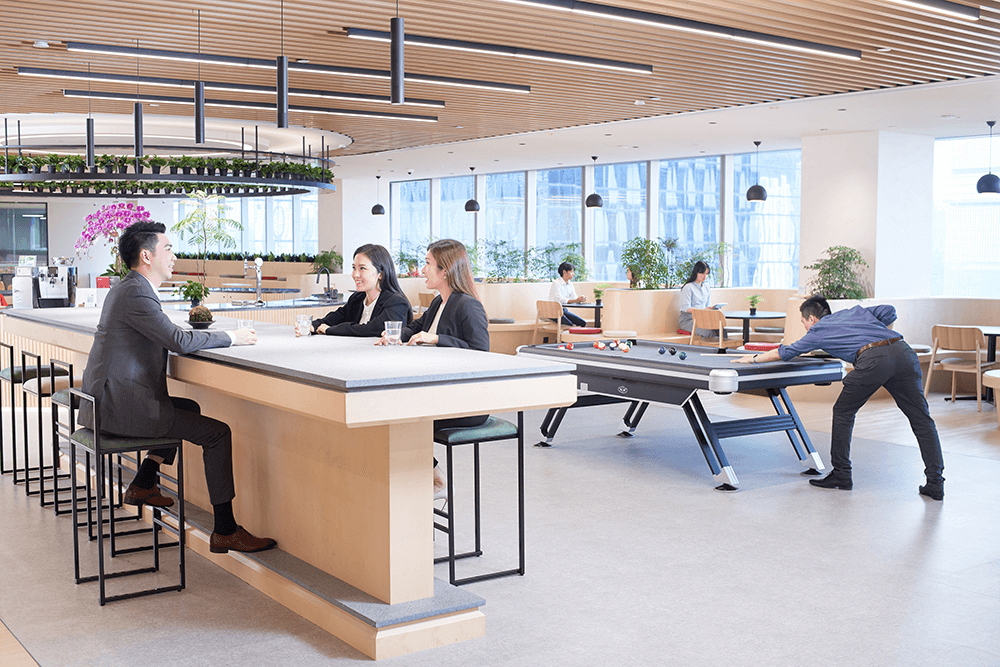Tailor-made smart workplace brings into full play advantages of hybrid work
 Apart from digital transformation, office transformation is also the way to go. To this end, companies can subscribe workplace design services to create smart workplace based on the operational features of the industries they are in, thereby boosting employees’ efficiency.
Apart from digital transformation, office transformation is also the way to go. To this end, companies can subscribe workplace design services to create smart workplace based on the operational features of the industries they are in, thereby boosting employees’ efficiency.Hybrid work is becoming increasingly popular today. With the incessant advancement of technology, many company employees can now work outside the office and enjoy more flexibility. However, simply installing cloud application services or computer equipment is far from enough if companies want to bring into full play the advantages of hybrid work. Apart from digital transformation, office transformation is also the way to go. To this end, companies can subscribe workplace design services to create smart workplace based on the operational features of the industries they are in, thereby boosting employees’ efficiency.
- The Covid effect and three factors driving the switch to smart workplace
- Low efficiency in workspace management
- A lack of collaborative spaces
- Optimisation of cloud and IT equipment
- Essential elements of smart workplace design
- Workspace insights
- Flexible workplace
- New type of conference room
- Seamless work experience
- Network resources management
The Covid effect and three factors driving the switch to smart workplace
During the three years of Covid-19 pandemic, companies around the world accelerated their switch to hybrid work in order to cope with quarantine and other healthcare measures. According to a poll, 28.2% of employees in the US have adapted to a hybrid work model so far this year. By 2025, an estimated 32 million Americans will adopt such a model. In sum, hybrid work is the big trend, and employees are now enjoying greater workplace flexibility. Meanwhile, workplaces have to undergo transformation due to three reasons:
| Low efficiency in workspace management | With employees enjoying greater workplace flexibility, the traditional arrangement of assigning a desk to each and every employee is outmoded. A space crowded with desks and chairs and a low employee attendance rate do not only undermine employees’ morale and space efficiency, but they also make it more challenging for company management to control consumption of office utilities such as lights and air conditioning. According to a survey, improving workplace design can help boost employees’ efficiency at work by 12%. |
| A lack of collaborative spaces | Deloitte, one of the four biggest accounting firms in the world, recently published a research report on the future of workplace. It indicated that nowadays when employees return to the office, they spend about 40% of their time in the office to collaborate and connect. According to another survey on workplace, nearly 77% of interviewees said collaborative spaces and equipment were essential to them. Therefore, company managers should upgrade their offices and transform them into smart workplaces. They should also adopt an office design that can be changed easily while maximising collaborative spaces for employees. |
| Optimisation of cloud and IT infrastructure | Under the hybrid working model, employees do not always have to go to the office. Therefore, company management has to provide employees with convenient, easy-to-use and secure cloud applications, such as online meeting and cloud file management tools. As for the physical office, the work environment should be BYOD-friendly (bring your own device-friendly) and has a stable internet connection, so that employees can work smoothly anywhere in the office. |
Essential elements of smart workplace design
When it comes to designing smart workplaces, companies should take into account the features in physical workplaces as well as online tools. They can also use workplace design services and seek advice from professional consultants.
| Workspace insights | Different sectors have their own operation model. It is best to seek workspace insights from professional consultants. Day-to-day operation data can be derived by using IoT sensors installed in the office, and based on data collected from work management platforms and tools. Such data can serve as a reference for designing smart workplaces and ensure the new design makes good use of every inch of the workplace. For example, employees who work in the office frequently can be arranged to work the same area, thus freeing up space to create a cosy, open area in the office. In that area, collaboration facilities can also be installed, such as a smart energy management system designed to enhance energy consumption efficiency and save costs. Dividing the workplace into different sections also facilitates workspace management, desk management and room management. |
| Flexible workplace | As the hybrid work model gives employees the flexibility to work in the office or any other remote location, hot desks can be installed in a smart workplace to minimise the number of non-essential desks and free up space to accommodate other features, such as a multi-functional area that can be turned into a small conference room or a team-building venue when needed. At other times, employees can take breaks in the area. Many smart workplaces today have an open design as opposed to an enclosed design with partitions and high cabinets. This way, employees can enjoy an open view in the office and communicate more effectively with colleagues. |
| New type of conference room | According to a survey, in business today, 80% of meetings are held between one to four people. In other words, big conference rooms are outmoded and a waste of space. Company management should consider putting in place smart pods, which are small in size, quick to set up and cost-saving. Multi-functional areas in the workplace can also be turned into a makeshift conference room to meet employees’ demand during busy periods. In terms of online meeting tools, they should be compatible with other office applications. For example, Microsoft Teams Rooms Solutions can be combined with interactive white-boards, making it easier for employees to follow meetings, voice their views and be more involved in meetings. |
| Seamless work experience | The hybrid work model enables employees to work both online and offline. There are various measures that a company can adopt to ensure their employees enjoy a seamless work experience. Apart from the aforementioned Microsoft Teams Rooms Solutions, cloud storage space and collaboration tools can be provided to employees so that they can synchronise and share files between different devices. As managers and other employees do not go to the office frequently, company management can consider using process automation tools to simplify or automate various approval processes to minimise slowdown of work procedures. |
| Network resources management | Under the hybrid work model, a company’s ability to support remote working is of paramount important. It is necessary to provide a physical workspace that can accommodate different types of equipment, including mobile phones, tablets and laptops, so that employees can store files anytime and anywhere and access applications. In addition, company management should be able to provide a stable wireless network connection, perhaps by putting in place a network management solution equipped with artificial intelligence (AI) technology, so that the internet speed can be accelerated or the network bandwidth increased where necessary. Another way is to automatically connect employees with the best connection hotspot when they move between different areas within a smart workplace, thus ensuring they enjoy a stable and speedy internet connection at all times. |
 To celebrate Ricoh Hong Kong 's 60th anniversary, we recently launched a new smart workplace. You are welcome to visit the new space.
To celebrate Ricoh Hong Kong 's 60th anniversary, we recently launched a new smart workplace. You are welcome to visit the new space.To celebrate Ricoh Hong Kong 's 60th anniversary, we recently launched a new smart workplace. The hybrid workplace is equipped with a variety of Ricoh products and solutions that enable employees to experience a brand new hybrid work model. You are welcome to visit the new space. Please register:
News & Events
Keep up to date
- 02Sep
Notice Regarding “Scan to Email Service” Issues
- 19Aug
Ricoh Asia Pacific and Microsoft Collaborate to Empower a Future-Ready Workforce Through AI
- 30Jul
Ricoh selected for inclusion in six ESG indices for Japanese equities adopted by the GPIF
- 24Jul
Updated: Ricoh’s Response to Basic Authentication Phase-Out in Microsoft Exchange Online SMTP Authentication

